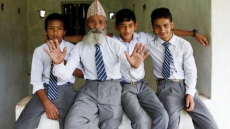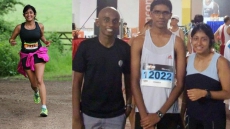NEW YORK — Scientists say the first baby has been born from a controversial new technique that combines DNA from three people — the mother, the father and an egg donor.
The goal was to prevent the child from inheriting a fatal genetic disease from his mother, who had previously lost two children to the illness.
The birth of the boy is revealed in a research summary published by the journal Fertility & Sterility. Scientists are scheduled to present details at a meeting next month in Salt Lake City.
The magazine New Scientist, which first reported the birth, said the baby was born five months ago to Jordanian parents, and that they were treated in Mexico by a team led by Dr. John Zhang of the New Hope Fertility Center in New York. It's not clear where the child was born.
The technique is not approved in the United States, but Zhang told the magazine, "To save lives is the ethical thing to do."
A spokesman for the fertility centre said Zhang was not available for further comment on Tuesday. Others involved in the research referred questions to Zhang.

The mother carries DNA that could have given her child Leigh syndrome, a severe neurological disorder that usually kills within a few years of birth. Her two previous children died of the disease at 8 months and 6 years, the research summary said.
The technique involved removing some of the mother's DNA from an egg, and leaving the disease-causing DNA behind. The healthy DNA was slipped into a donor's egg, which was then fertilized. As a result, the baby inherited DNA from both parents and the egg donor.
The technique is sometimes said to produce "three-parent babies," but the DNA contribution from the egg donor is very small.
People carry DNA in two places, the nucleus of the cell and in features called mitochondria, which lie outside the nucleus. The technique is designed to transfer only DNA of the nucleus to the donor egg, separating it from the mother's disease-causing mitochondrial DNA.
The research summary identified the mother as a 36-year-old woman and said her pregnancy was uneventful. One of the five eggs the researchers treated was suitable for use.

Critics question the technique's safety, saying children would have to be tracked for decades to make sure they remain healthy. And they say it passes a fundamental scientific boundary by altering the DNA inherited by future generations. Mitochondrial DNA is passed from women to their offspring.
Still, last year, Britain became the first country in the world to allow creation of human embryos with the technique. In the U.S., a panel of government advisers said earlier this year that it's ethical to test the approach in people if initial experiments follow certain strict safety steps.
That report was requested by the Food and Drug Administration, which is currently prevented by Congress from considering applications to approve testing the technique in people.
Shroukhrat Mitalipov, who has worked with the approach at the Oregon Health & Science University in Portland, said that given the panel's conclusion, "We believe it's time to move forward with FDA-approved clinical trials in the United States."

Henry Greely, who directs the Center for Law and the Biosciences at Stanford University, said Tuesday he sees nothing wrong with using the technique if it is safe and is aimed at diseases clearly caused by faulty mitochondrial DNA.
But he called the research leading to the newly reported birth "unethical, unwise, immoral." He said the approach "hasn't been sufficiently proven safe enough to try to use to make a baby."
Dieter Egli of the New York Stem Cell Foundation, who has done work in the area, was cautious about the implications of the new report.
"I wouldn't go out there at this point and tout the accomplishment because we don't have enough information," he said Tuesday. "We do not know exactly what was done."
"We have to wait" for a fuller report, he said.

The child is not the first to inherit DNA from three people. In the 1990s, some children were born after researchers used a different technique. But federal regulators intervened, and the field's interest now has passed to the new approach.





